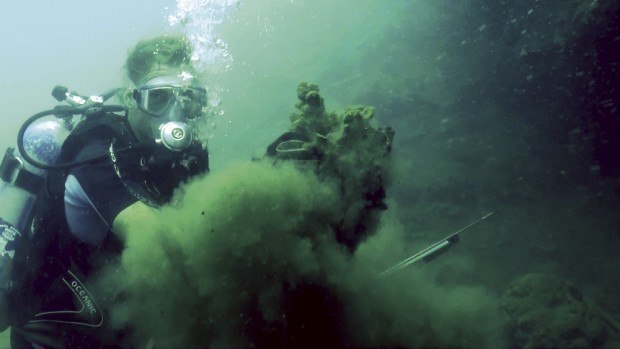Tests show toxins polluting Hanalei river mouth, bay


After years spent studying Hanalei’s river and bay, biologist and avid scuba diver Terry Lilley could find no recent government tests to confirm what he suspected — high levels of pollution.
So Lilley’s Hanalei River Heritage Foundation paid $2,000 to have mud samples from the river’s mouth and bay tested by the Honolulu laboratories of Washington state-based TestAmerica Laboratories Inc.
What the tests show are high levels of arsenic, barium, chromium and lead, the report states. Future tests will look for dioxin and other contaminants, Lilley said Sunday.
“This is basically the start of a public campaign to start a cleanup of Hanalei Bay and the river. We have a huge problem,” Lilley said.
Lilley said he has been studying the reefs in Hanalei Bay since 2006, and that he discovered corals were dying in shallow water.
He suspected it was due to the continual mud flowing from the Hanalei River into the bay.
Then he said he became sick last year while diving, and heard that other people were getting sick, too.
“I’m not the expert on the topic of river contaminants, who would say what toxins make what people sick, but we have a major problem that needs to be fixed,” he said.
“Basically, there should be zero levels (of the heavy metals found) in the bay.”
After the report arrived last week from TestAmerica, Lilley took copies to an environmental meeting Saturday at the Kapa‘a Library hosted by the Wailua-Kapa‘a Neighborhood Association.
“People were appalled,” he said, and the guest speaker, Gary Hooser, director of the state Office of Environmental Quality Control, told Lilley he would show copies of the report to the state Department of Health.
The TestAmerica report states that the samples of mud were collected properly. “The samples arrived in good condition, properly preserved and on ice,” the report states.
Testers used milligrams per kilogram (mg/Kg), which they said is comparable to parts per million (or ppm), which is a measurement used in other studies.
What the report of the river sample water shows are: 29 mg/Kg of arsenic, 19 mg/Kg of barium, 120 mg/Kg of chromium and 2.4 mg/Kg of lead.
What the report of bay water shows are: 18 mg/Kg of arsenic, 7.0 mg/Kg of barium, 65 mg/Kg of chromium and 1.3 mg/Kg of lead.
Don Heacock, the Kaua‘i District aquatic biologist for the state Department of Land and Natural Resources, said Sunday night that more tests are needed to find out if these levels are higher than normal.
But he is concerned, and said “immediate” action should be taken to determine those levels.
“I’m concerned about anything that might be toxic to our community,” he said.
Heacock said what Hanalei residents can do in the meantime is visit the Environmental Protection Agency website and research the 319 program.
Heacock said the 319 program is a grant program to help watershed communities inventory their resources to find out if there are contaminants in their water and also in their fishery resources.
“Without a healthy environment, we have nothing, so we need to make sure we either don’t negatively impact our water resources or, if they are negatively impacted, we need to correct them,” he said.
Lilley said it is a violation of the Clean Water Act to dump muds and metals into Hanalei Bay, but that he has photographed and videotaped occurrences of these actions over the past two years.
He said he has regularly notified the Department of Health, EPA and other federal agencies in recent years about concerns he has as a resident about the water in Hanalei.
“I feel it is good to let the public know what is going on in Hanalei Bay so they can pressure the government to enforce the Clean Water Act and Endangered Species Act on the North Shore of Kaua‘i,” Lilley said.
“My purpose is to clean up Hanalei Bay so it is safe for myself and children to surf and dive in,” he said.
• Renee Haines, managing editor, can be reached at 254-3681 (ext. 227) or by emailing rhaines@thegardenisland.com
